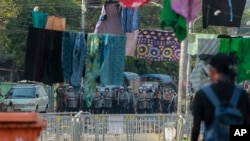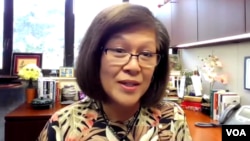A Myanmar human rights activist told VOA in a recent interview that the ruling junta in Myanmar “is using rape and other violence against women as a bigger part of its campaign to crack down against opposition groups.”
May Sabe Phyu organized women’s demonstrations in the anti-coup protest movement. She fled Myanmar in April 2021 under threat of arrest and is now a visiting fellow at the Southeast Asia Program at Cornell University. She and other female Myanmar human rights defenders formed the Women Advocacy Coalition Myanmar in May 2021 to strengthen and support the role of women in the anti-coup movement.
She said the junta wants to “scare people, whoever is against the coup, using fear as a weapon and women’s bodies as a battlefield.”
The National Unity Government (NUG) Ministry of Women, Youth and Children’s Affairs and the National Unity Consultative Council Joint Coordination Committee on Gender Policy said in a March 8 joint statement that junta troops have sexually assaulted at least 122 women since the beginning of the coup two years ago. At least 3,125 women have been detained in that time, 15 of whom have been sentenced to life in prison by the junta, and 11 more who face the death penalty, according to the statement.
VOA reached out multiple times by phone to the junta spokesman about the serious allegations in the March 8 statement, but he declined to take the telephone calls or respond to the sexual assault charges leveled at troops.
VOA recently reported on one of the latest examples of sexual violence, where junta troops raided Tar Taing village in the seat of Sagaing region on March 1, killing at least 17 civilians, three of whom were women. The women had been gang-raped by the soldiers before being shot and killed. The attack was seen as part of a recent escalation of violence against civilians by the military junta in Myanmar.
The Thai-based Assistance Association for Political Prisoners said in February that more than 4,000 women had been arrested or detained since the beginning of the coup in February 2021. It also said that the number of women killed in the conflict had reached around 400, with some women being killed in military action, or even burned alive. The organization has been documenting arrests and killings in Myanmar since the coup.
The death toll and arrest numbers are based on limited information that can be difficult to collect on the ground in Myanmar. Human rights groups estimate that the number killed could be much higher. The junta has not officially responded to the latest AAPP reports but has in the past rejected the numbers, calling them baseless.
“If we talk about the number of women dying from the ongoing conflict,” May Sabe Phyu said, “we should include women who hide in the forest and die in childbirth or [of] disease because of [the] lack of health services. We estimate that the number of women dying in Myanmar as a result of the coup is much higher, but we don’t know the true toll yet.”
The office of the U.N. High Commissioner for Refugees said last year in its Global Appeal 2023 report, violence against civilians and the intensified armed conflict following the coup has caused tens of thousands of refugees to flee into neighboring countries and has displaced more than 982,000 people within Myanmar. The report estimates there are 1.35 million internally displaced people (IDP) in the country, mainly women and children.
Junta increasingly targets women
“Women have been fearlessly resisting the tyrannical rule of the junta since the beginning of the coup over two years ago. Women are courageous, smart, and in leading roles in the revolution, that’s why the junta is targeting us,” May Sabe Phyu said in an interview at VOA’s Washington headquarters.
“Women are our future leaders,” she said. “In Myanmar, as in the rest of the world, women often have to use innovative ways to get noticed. We have been innovative in our resistance to the military’s oppression, and now we cannot be denied as a force to be reckoned with, that’s why we are being targeted more and more, specifically with sexual violence.”
Miemie Winn Byrd, a Burmese American academic and former U.S. Army lieutenant colonel, struck a similar note.
“There are more women involved in the resistance movement,” she told VOA by Zoom March 29. “You can see more women being arrested and killed, because they're on the front lines, they're a part of the conflict,” she said.
“Most of the victims tend to be women,” she said, “it’s just the anatomy of conflict. Women generally suffer more in conflict than men, and they suffer more when they are arrested because the military uses sexual assault to interrogate, punish and abuse the women in captivity."
In its March 8 statement, the NUG said it would “continue to fight for justice for women whose rights have been violated.”
“Myanmar military is no longer acting like a professional military organization,” Byrd said. “It has become like an organized crime syndicate, using tactics that are not normal for militaries. They are breaking every human rights law.”
Female political prisoners unprotected
According to accounts from VOA sources and news reports, attacks against female prisoners by male prison guards working at Obo prison, in Mandalay, Myanmar’s second largest city, underline the challenges faced by women in Myanmar. The guards reportedly beat the women in captivity, leaving the mostly political prisoners with severe injuries, including head wounds, bruised faces and broken bones.
May Sabe Phyu said the recent reports of attacks inside Obo prison have caused concern among prisoners’ family members, who say they also fear retribution by the junta. May Sabe Phyu said using men to guard female prisoners is against Myanmar’s prison code, something many other activists and human rights watchers say.
According to the Myanmar prison rule book published in 1992, male guards are not allowed to enter dormitories housing female inmates without the presence of female guards. VOA contacted prison authorities by phone about the assault allegations but have yet to receive a response.
Women on the front lines
Women are playing a critical role in the current anti-coup resistance movement in Myanmar, Byrd said.
Research data, she said, shows that about 60% of resistance forces are made up of women.
“Many are involved in fundraising and are involved in information operations online. Also, much of the logistics as well as humanitarian assistance delivery is provided by women,” she said.
“In previous resistance movements, [in Myanmar] women were there,” Byrd said, but much less than 50%.
“The amount, the level of women that are involved today is amazing, unseen before. The protests were actually started by women, initially. They have evolved into armed resistance, and now women are behind the armed resistance as well,” she said.
Gabriela Sagun, program specialist for the Burma and Southeast Asia programs at the United States Institute of Peace (USIP), agrees with Byrd.
“Young women have been instrumental to the resistance movement,” she wrote in an online publication for USIP, “with some fighting in the all-women PDF [Peoples Defense Forces] unit, Myaung Women Warriors, and others joining fledgling security and police groups to help stifle injustice in Burmese society. In urban areas, women help to move supplies to the front lines.”









